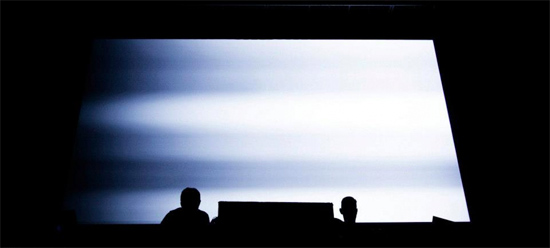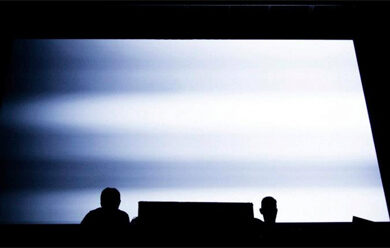Thursday night, 1am. I’m standing in the relative cold of a Brussels autumn night smoking a cigarette while a stranger I’ve just met is talking to me. He’s wearing a Chinese vest and tells me he runs a network of independent music festivals around the world. "It’s all a little incestuous," he says with a sly smile. I’ve no problem believing him, if there’s one thing I’ve learnt, it’s that a big part of the whole music and art world is ultimately about who you know.
I’m in Brussels for the first edition of the Bozar Electronic Arts Festival. Don’t let the number deceive you though, the festival has been running for a number of years but has been rebooted under its Electronic Arts guise in 2012. I first attended last year and it would appear that the main difference is a change of focus from electronic music to a combination of both music and visual arts that have a relation to the electronic world. Bozar’s main appeal, however, is its location, inside Brussels’ Palais des Beaux-Arts. This is a festival in a city-centre museum, the sort of thing we don’t really get in London, and this year the organisers brought to the Belgian capital a line-up that neatly balanced international appeal – Hype Williams, Howse, Ben Frost, Gold Panda, Nguzunguzu and Andy Stott – with homegrown talent – Sendai (pictured, top), Peter Van Hoesen, Yannick Frank and the Vlek label.
According to the guy in the vest – I never remembered his name – it’s been a long time since Belgian music had its time in the public light; not since new beat at least. It’s hard to argue with him – I’m unable to think of many Belgian artists that have made a big impact worldwide outside my own, specific musical interests. The following morning, I remember that 2 Many DJs and also Lefto are perhaps exceptions to that statement, but I never get a chance to tell him that.
Bozar takes place over three nights and an open afternoon from Thursday to Saturday. Its location inside the museum gives it a spatial quality that’s both refreshing and crucial, allowing for the re-contextualisation of public spaces that are often left to the hands of people who may deem electronic music and its varied modern, populist offshoots irrelevant to the ‘higher’ pursuits of culture and the arts. That was one of the strongest impressions the festival made on me when I first visited, an impression confirmed this year by speaking to one of the organisers. While Belgium has had its fair share of political brouhaha – it didn’t have a government for the last four years – it’s one of the few European countries I know of that’s genuinely putting its money where its mouth is when it comes to supporting culture and the arts. As the organiser explained, his work involves showing those in positions of power the value of opening up spaces such as the Palais des Beaux-Arts to new audiences and new artistic practices.
With this in mind the space felt busier last year. Last year’s was much more club-like whereas this year it’s more subdued and gentle. The added visual dimension seems to be partly responsible for this gentler vibe, adding perhaps an air of artistic refinement to what is essentially a party in a museum. Last year’s headliners included Rustie and Jacque Greene, who both performed in the museum’s main hall, then transformed into a massive – and rather dramatic thanks to its stone columns – club/rave space. This year the main hall is home to a continuous looping visual installation by Ryoichi Kurokawa that’s both relaxing and impressive. While the visual side of things is still secondary to the music – there are only two fixed visual installations alongside some showcase areas and individual projections in the other rooms – it’s a pleasant addition to what Bozar is trying to do.
There’s something to the name Bozar too. It’s no doubt a simple marketing ploy yet I can’t help but think that it remains a neat linguistic play on words for what the festival is trying to do – the word is spelt as Beaux-Arts is pronounced, but in text-speak (like m8 or l8r in English). It’s another way to take the concept of Beaux-Arts from something old, established and perhaps unattainable for most, to something younger and more inclusive. And at least it’s not totally cheesy.
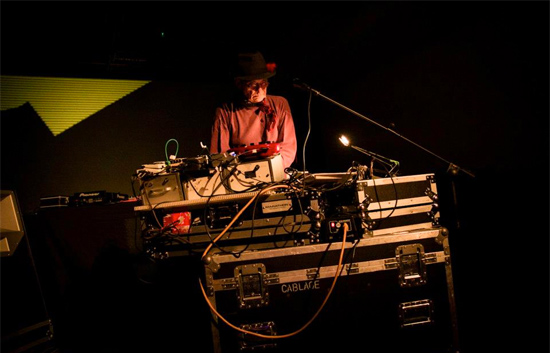
Silver Apples
With the unfortunate last minute cancellation of Demdike Stare on the first night, the highlight is Silver Apples. Remaining member Simeon, now pushing into his 70s, wows the audience with his own psychedelic take on techno and electronic music, refined over the last four decades. Proving that age is definitely all in the mind, he runs across the stage attending to various machines while keeping things groovy. It feels oddly appropriate that his is the most memorable moment of this opening evening, connecting the old and the new. Robin Fox’s laser performance follows, turning this year’s main room – and the only one with a dancefloor – into a mesmerising light show that puts most club lasers to shame.
Friday evening is the most exciting on paper, with a dual line up that pits Belgian acts against the international invitees. While the international acts (all from the US except for Gold Panda) have the keys to the dancefloor room, the Belgian acts are all put into the ‘Studio’, a seated room better suited to the music on offer yet where you can’t take your drinks with you. While that limitation is understandable considering the location, it’s never going to go down too well when you’re having a party, even if it’s in a museum and trying to be "arty" about it. Hype Williams kick things off on one side in predictably confusing fashion with a show that’s pre-recorded and features tons of smoke, strobes and Dean Blunt sitting on a motorbike doing, well, nothing. Meanwhile Belgian duo MS30 offer an interesting take on noise coupled with surreal discussions of what their art is, and how it could or should be marketed. The strange dichotomy offered by both line ups, dance music versus experimental, noise and drone, and their location, an intimate dancefloor versus a cold, seating-only room, proves to be the evening’s most entertaining aspect. US acts Time Wharp and Howse follow nicely from Hype Williams though they never came anywhere close to the physical pressure or disorientating sensations that even a pre-recorded show from Blunt and Copeland can evoke. The relentless reliance on triangle shapes for visuals at one point doesn’t particularly help, either.
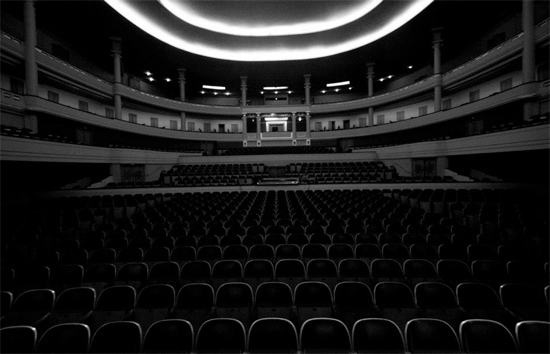
Over in the Studio, Yannick Franck offers the best performance of the three Belgian acts on the bill. Sitting down to watch him at the front of the room, I’m assaulted by low end, almost to the point of feeling uncomfortable. Having laid a solid bedding down he adds layers upon layers of hypnotic grooves, echoing techno sonically but never straying too deeply into tropes or clichés. The only thing preventing you from becoming swept away in the sonic miasma is his jolting use of his own voice to add organic texture to the mix. This sort of experimental loop-based approach perfectly suits the room and mood, man and machine becoming further and further intertwined until the only reminder of a human presence is the voice. The following act, Martiensgohome, spend their time pumping out a steady stream of drone from behind their four computers whilst managing to look like they’re either bored or checking their Facebook. That’s art for you I guess.
Gold Panda and Nguzunguzu close the main room with a ‘rave in a museum’ vibe, especially when Nguzunguzu take control and send everyone off into the night with tough, sound system pushing riddims (all rooms were fitted with nicely tuned Funktion 1 rigs, which was a touch).
A sizably hungover Saturday finds me sharing a breakfast table with none other than Dean Blunt from Hype Williams, which is both funny and a little awkward considering the previous night’s happenings. As it turns out he’s pleasantly honest and open about the performance, rightfully pointing out that electronic music festivals such as this can sometimes be quite dry and impersonal (I’m paraphrasing here by the way). They’d apparently agreed from the beginning that it wouldn’t be a live performance, pushing it towards something more akin to an art installation – in which case it’s the best one of the festival.
The best part of the last day isn’t the evening’s line up but the open afternoon. Alongside the two visual installations is a 3D printing installation/workshop. A fair few kids had gravitated towards it, mesmerised by the buzzing machines and their ability to create any shape the kids could summon on the computers. Also, when you’re hungover, 3D printers are even more amazing in the flesh than on YouTube videos.
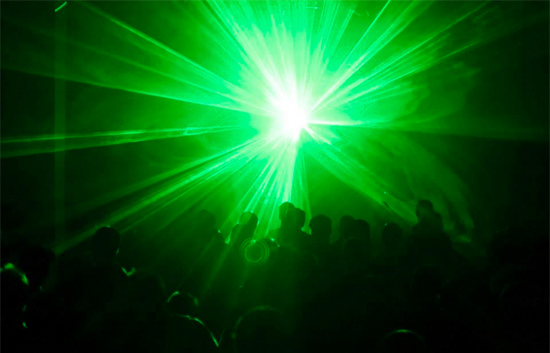
Robin Fox
Alongside these installations the festival sets up two panels to showcase Belgian technological innovations related to electronic music. First up are the Vlek label, who have invited reclusive producers Herrmutt Lobby (responsible for one of the most slept on experimental rap albums of the 00s, Hunter with Shadowhuntaz’ Non Genetic) to showcase the Beatsurfing app that the pair developed, alongside Yaniv De Ridder, and released via the label earlier this year. Getting an insight into what drove the app’s creation, as well as demos of its current and future capabilities, is a reminder that talks such as these are one of the better ways to open up the often arcane and mysterious world of modern electronic music production and performance to a wider public. Here’s to hoping the festival realises this and puts more focus on the afternoon’s activities next year.
Vlek’s presentation is followed by one from Brussels’ La Mediatheque, who present their new Beat Bang app which offers the public a look at the history and evolution of electronic music from 1988 to the present. The app essentially acts as a both an overview and primer on electronic and dance music evolution worldwide using a touch screen interface to let the user discover the music and its relations – and of course listen to it. Interestingly, the app’s creators chose to base its navigation on an x/y axis that utilises years and bpm, instead of genres. Explaining the reason behind the move, one of its creators argued that by focusing on bpm instead of genres as one of two key definers, they hoped to stop people from being too preoccupied by the limitations that come with thinking in terms of stylistic boxes, an interesting move that echoes a fair few on-going discussions surrounding genre naming and its usefulness. It’s a project that not only has great potential but is another pleasant reminder that there are a lot of unexplored possibilities within the app world for educational initiatives such as this. Considering that a big part of the 500 or so albums that form part of Beat Bang originate from the UK, I find it hard to not think that this is precisely the sort of thing that should be happening over here, if only to celebrate the country’s artistic patrimony.
The festival closes with two performances in a giant seated hall followed by another double bill of dancefloor-based music and seated drone and experimental action. Sendai, the Belgian duo composed of Yves de Mey and Peter Van Hoesen, perform a mesmerising if slightly headache-inducing show in the main hall. The giant visuals that accompany them remind me of the work of Ryuichi Sakamoto and Alva Noto. Relentlessly alternating between quite brutal beats and drone soundscapes, the pair pull off some interesting rhythms and textures. The setting of a royal listening hall with a more-than-capable sound system seems fitting for an audiovisual sensory overload capable of either kicking your night off to a good start or sending you looking for the exit. The rest of the night proves similar to the previous evening. The Haxan Cloak and Raime perform in the seated area, giving me a migraine I didn’t know I wanted, while in the dancefloor room Andy Stott pulls off an engaging set that had the audience pining for more from start to finish.
Bozar’s reboot as an Electronic Arts festival still needs refining but, given the quality of the location, the potential is there if the organisers continue to work on and expand the most enticing aspects. And with that, it might just give Belgian music and art another run in the spotlight.

